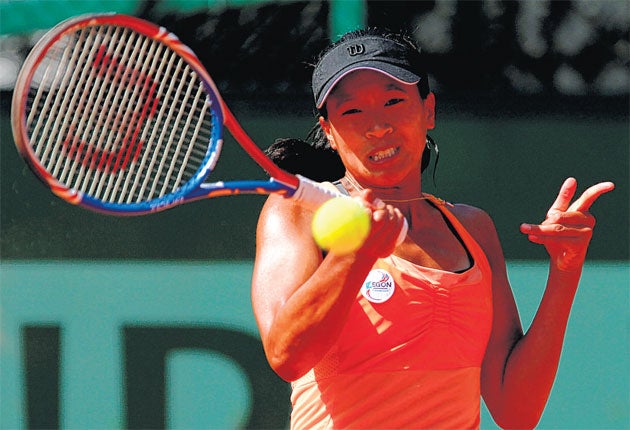Keothavong crumbles to leave British women bereft once more

Court 16 is about as far away as you can get from the centre of Paris here at the French Open. Even though Roland Garros is the smallest of all the four Grand Slam tournament sites, it can feel like you should be in the adjoining Bois de Boulogne by the time you reach Court 16, having skirted round the main arenas of Court Philippe-Chatrier and Court Suzanne Lenglen.
The organisers seemed to regard it as an appropriately obscure place for Britain's women to start their attempt to end a 17-year wait for a win on these courts, dating back to Clare Wood's victory over Gigi Fernandez in 1994. Three hours and 21 minutes later the wait was still going on as Anne Keothavong was beaten 3-6, 7-6, 6-4 by Russia's Vesna Dolonts, having gone within two points of victory in the second set tie-break.
The British No 2's defeat left Heather Watson and Elena Baltacha to pick up the baton. Baltacha plays today against American Sloane Stephens, while Watson, who last week became the first British woman to come through the qualifying tournament here for 28 years, was due to play yesterday's final match on Court Six against France's Stephanie Foretz Gacon.
While few British players spend their early years learning the game on clay, plenty have returned from cross-Channel expeditions with more than red-stained socks in their luggage. Since the Second World War, Angela Mortimer (1955), Shirley Bloomer (1957), Christine Truman (1959), Ann Jones (1961 and 1966) and Sue Barker (1976) have all won the title here.
Keothavong was making her third attempt to win a match at the French Open. Given that she had met Dinara Safina (then world No 1) and Flavia Pennetta (No 15) in her two previous appearances, this was clearly her best chance yet. Dolonts, just seven places higher at No 101 in the world rankings, was making her first appearance in the main draw here and only her fourth at any Grand Slam tournament. Such is the depth of Russian tennis that the 20-year-old Muscovite has 16 of her fellow countrywomen ranked above her.
While some British players can look as happy on clay as a lobster in a brasserie fish tank, Keothavong has performed well on terre battue in the past, reaching the quarter-finals and semi-finals of events on the main tour. Recent form, however, offered less encouragement. In her four previous clay-court matches this year Keothavong had not won a set, while Dolonts arrived here with four wins in her previous two tournaments.
Keothavong, who had won both their previous encounters three years ago, started as brightly as the Parisian sun, which beat down from an almost cloudless sky on a beautiful spring morning. The 27-year-old from Hackney, striking the ball with confidence and moving smartly, took the first set in 49 minutes, after which Dolonts took a lengthy medical time-out for treatment to her right foot.
The Russian picked up her game in the second set, failed to serve out at 5-4 and 6-5 and appeared to be blowing another chance when she let slip a 5-2 lead in the tie-break. At 5-5, however, when just two points from victory, Keothavong put a second-serve return in the net. Dolonts dominated the next point to level the match.
With her quad muscles tightening, Keothavong sent for the trainer before serving at 4-5 in the decider. From deuce the Briton put a tired forehand in the net and then served a double fault. Both players had won 117 points in the match, but the only statistic that mattered sent Dolonts through to a second-round meeting with the defending champion, Francesca Schiavone, who was a 6-2, 6-0 winner over Melanie Oudin.
Keothavong, who has been in tears after past defeats in Grand Slam tournaments, tried to put a brave face on her latest disappointment. "I definitely had my opportunities," she said. "In hindsight, I can look back and there are a number of things I could have done – points here and points there – but it didn't happen and I'll just have to move on."
Asked whether she regarded it as a missed opportunity, Keothavong replied: "It's definitely frustrating. As you get older you learn to deal with it and handle it a little bit better than perhaps when I was younger, but it's a loss, it hurt, especially when I felt like I had my chances, no doubt about it. But I'm the best at beating myself up. I don't need to be told it."
Keothavong admitted that playing on clay was a learning experience for most British players. "I've had some of my best results on clay, but it's a surface that we don't grow up playing on," she said. "When I was younger, I grew up playing on hard courts and artificial grass. Those are the courts you get at your clubs. I think there are more clay courts around now.
"It's just a different kind of mentality, working on your patience, and if you do grow up playing on clay, it does teach you a lot. You can learn to add a bit more variety to your game from a younger age, learn to be a bit more creative in the points."
At least Keothavong can now enjoy a period back home as she embarks on her grass-court campaign. She will play in two successive Challenger events in Nottingham, skipping the Aegon Classic at Edgbaston in the hope of getting more matches under her belt in the build-up to Wimbledon.
Subscribe to Independent Premium to bookmark this article
Want to bookmark your favourite articles and stories to read or reference later? Start your Independent Premium subscription today.

Join our commenting forum
Join thought-provoking conversations, follow other Independent readers and see their replies